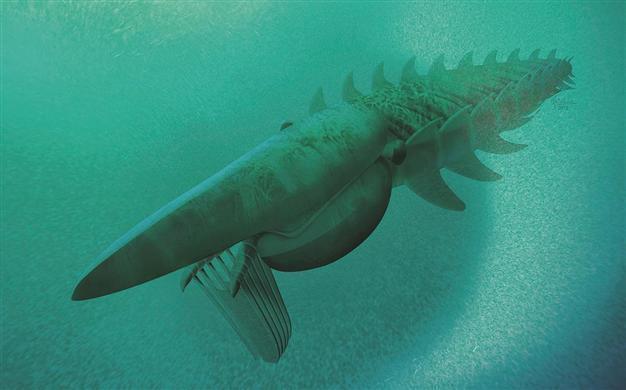Gigantic ancient arthropod was really 'a very peaceful guy'
WASHINGTON-Reuters

The reconstruction of a filter-feeding Aegirocassis benmoulae from the Ordovician Period feeding on a plankton cloud is shown in this artist rendering released to Reuters on March 10, 2015.
It was big. It was weird. And this monster from the primordial seas was also a trend-setter.Scientists on March 11 announced the discovery in southeastern Morocco of beautifully preserved fossils of a huge arthropod - the group that includes crabs, scorpions, insects, spiders, centipedes and more - that lived 480 million years ago.
It was Earth's largest animal at the time, at least double the size of anything else, said Yale University paleontologist Peter Van Roy, who led the research published in the journal Nature. Despite its size, it was a gentle giant that ate only plankton.
The creature, called Aegirocassis benmoulae, was at least 7 feet (2.1 meters) long. It is the last known member of a group called anomalocaridids that included some of the first top predators near the dawn of animal life.
Almost all the group's members were active predators, grabbing prey with appendages sprouting from their heads. Aegirocassis adopted another feeding strategy. Its appendages acted as a sieve, capturing oodles of plankton.
Periodically during Earth's history, large predatory animal groups have produced exceptionally big species that were filter-feeders, not active hunters. Exploiting a plankton explosion during the Ordovician Period, Aegirocassis represents the beginning of this trend, foreshadowing today's baleen whales and whale sharks.
"Given the huge size of Aegirocassis and its very alien appearance, I assume most people would probably be terrified if they'd encounter it while swimming. However, contrary to almost all other anomalocaridids which were active predators, our animal would have been a very peaceful guy," Van Roy said.
Aegirocassis possessed a torpedo-shaped head, an elongated body with 11 segments and two sets of flaps, considered precursors to the limbs of more advanced arthropods, along the side of each segment.
The lower flaps were used for swimming, with rhythmic undulations. The upper flaps stabilized the animal in the water and helped steer at higher speeds.
Ribbon-like structures, probably functioning as gills, covered its back. Two appendages near its mouth were specialized for filter-feeding, with a series of spines lined with bristle-like structures to sweep up small animals and particles.
"The discovery informs about the origins and early evolution of arthropods, the most ubiquitous, species-rich, morphologically diverse and successful animal group on Earth," Van Roy said.
Anomalocaridids, first appearing about 530 million years ago, sit very low on the arthropod evolutionary tree, making today's arthropod multitudes distantly related to them.
Aegirocassis joins ancient giant sea scorpion Jaekelopterus and millipede-like land dweller Arthropleura as the largest known arthropods.
















